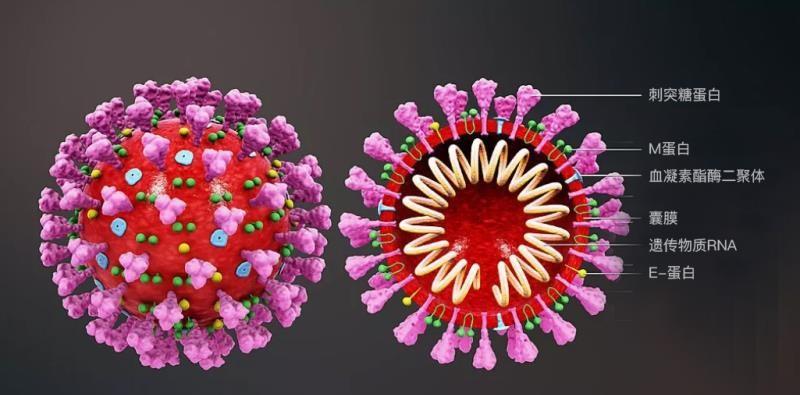This article is written by Ma Chenhao, surgical resident of Peking Union Medical College Hospital
The COVID-19 pandemic has caught us off guard too much, and it all has to do with the emerging virus, severe acute respiratory syndrome coronavirus 2 (SARS-CoV-2).
Why a small virus has such a great power, in order to understand its function, you need to start with understanding its structure, after all, structure determines function.
First, the structure of the new crown virus
First, we need to know that the virus is called SARS-CoV-2. This novel coronavirus is a coronavirus along with SRAS.
Coronaviruses are named because they can be seen under the microscope with distinct rod-like particle bulges shaped like crowns of medieval European emperors.

Next, take a closer look at the structure of the virus from the outside in. There are three proteins in the outermost layer of the coronavirus, called spike glycoprotein, small envelope glycoprotein (M protein), and membrane glycoprotein (E-protein).
Among them, the spike glycoprotein mainly recognizes and binds to host cell surface receptors, and plays a key role in mediating the fusion of the viral envelope with the cell membrane. In layman's terms, spike glycoprotein is like a key, and its main role is to open the cell membrane of the host cell.
Subsequently, the envelope on the surface of the virus is also called the capsule membrane, which is mainly lipid components, associated with the lipid bilayer of the human cell membrane and the chemical similar compatibility principle, to some extent this structure makes it easier for the virus to enter the host cell.
Finally, inside the cell, there is a forward single-stranded structure of RNA, as RNA is no double-stranded structure, and there is no ability to match the error correction of DNA, so the new crown virus is more likely to mutate.
To be clear, this RNA structure provides the structural basis for RT-PCR, the "gold standard" for COVID-19 detection.
Image source: Stand Cool Helo
Second, the process of the virus attacking the human body
Having completed the structural observation of our enemies, we may wish to examine the virus raid in a local battle.
First, we need to make it clear that viruses cannot survive on their own, that is, they must parasitize other host cells.
When a virus parasitizes a cell, it often goes through four steps: adsorption and cellularization, dehulling, biosynthesis, assembly and expulsion.
1. Adsorption and cell entry: In the adjacent position where the virus enters the alveoli through the respiratory tract, the virus binds specifically to the door lock of some cells such as ACE2 receptors through the spinous protein as a key, thus cleverly deceiving the cell, opening the portal, and rapidly passing through the lipid bilayer through the lipid envelope and entering the host cell.
Compared to other organs, human respiratory ciliary cells and alveolar epithelial cells have higher levels of the ACE2 protein, which explains why the new crown virus chooses the lungs to attack in the first place.
2. Dehulling: After the virus enters the cell, the virus will inactivate it by attracting the cell factory picket- lysosomal through its disguised coat - protein nucleocapsid, a step called "dehulling".
As a result, the virus's genetic material, RNA, is completely exposed to the cell. Of course, it will not be satisfied with this alone.
3. Synthesis: When the genetic material RNA encroaches on the cell's synthesis workshop, the ribosome, the virus finally begins its wanton reproduction, a step that "synthesis" focuses on re-producing the important accessories needed to produce the virus, and thus maps again to our previous description of the structure of the virus:
First, unidirectional positive-stranded RNA directs the synthesis of a large number of virus-associated proteins, including nucleocapsid proteins.
Second, unidirectional positive-stranded RNA is transcribed into negative-stranded RNA by using itself as a template, resulting in new offspring positive-stranded RNA. This process is repeated, resulting in a large number of new RNA.
o Third, after the negative-stranded RNA is selectively converted to a fragmented positive-stranded RNA, various small proteins are specifically synthesized.
4. Assembly and Exodus: At this point, we have obtained three main accessories and are ready to complete the core assembly. Some theories suggest that the lipid envelope is mainly obtained by turning the lipid membrane components into themselves when the cells pass through the endoplasmic reticulum or cell membrane.
Image source: Stand Cool Helo
So far, the virus has completed the whole process of one replication.
What will happen to its fate after that? Whether it is long-term lurking or waiting for an opportunity, this involves the reincarnation of the virus, which can choose to increase with the passive replication of cells, or it can multiply in large quantities, causing direct toxic killing and resource encroachment on cells.
If you are a virus, what choice will you make in order to maximize the benefits of your own cluster?
Image source: Stand Cool Helo
*The content of this article is a popularization of health knowledge and cannot be used as a specific diagnosis and treatment recommendation, nor is it a substitute for face-to-face consultation by a practicing physician, for reference only.
*The copyright of this article belongs to Tencent Medical Code, unauthorized media reprinting is prohibited, and illegal reprinting will be investigated for legal responsibility according to law. Individuals are welcome to forward to the circle of friends.